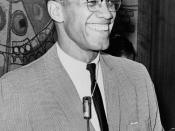CONTENTS
I. INTRODUCTION
II. CHILDHOOD
III. CRIMINAL YEARS
IV. CONVERSION TO MUSLIM
V. INFLUENCE OF ELIJAH MUHAMMAD
VI. MECCA
VII. THE ASSASSINATION
VIII. CONCLUSION
It has been nearly 35 years since the assassination of Malcolm X, yet the stature of the man remains in tact, if not even greater today. His war against the white establishment evolved from inner needs just as he had rebelled against symbols of authority early in his life. It was this early rebellion and the phases that followed, that enabled him to adapt to his later environment. Malcolm X coped with painful ordeals by forgetting them or remembering them in a brighter way. He wanted happiness and love, but kept himself from it, and he often defied the very persons from whom he was seeking approval. He defended his people and helped them understand that blackness is not a sign of shame but a symbol of pride.
However, throughout his life Malcolm had many issues with his own color and the pride he would take in himself.
Malcolm X, born Malcolm Little was the seventh child, (three from a previous marriage), of Reverend Earl Little, a pronounced minister and dedicated organizer for the Universal Negro Improvement Association, and the fourth child of Louisa, a native of the Caribbean island of Grenada. When he was born his father wired his parents, " It's a boy, but he's white, just like mama." (Bruce Perry, 11) Malcolm's skin color was an obstacle from his very first breath. His eyes were blue-green, his hair was ash-blonde, and his skin light in color. His paternal grandmother was appalled at his appearance, as it reminded her of the white blood in her veins. His grandfather wept and declared that no albino would be named after him.
Because of the great...


